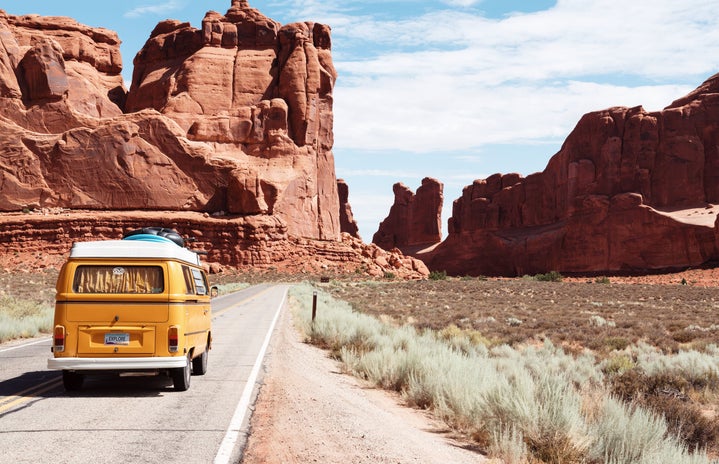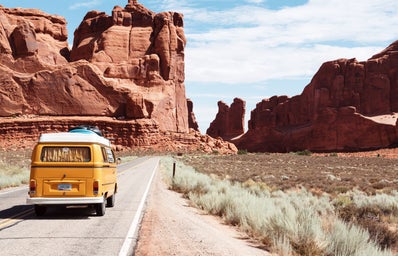Spring Break is coming up and FAST and after the wave of midterms hitting us in the next week or two, Spring Break planning will commence and finalize. Now, some of you will be flying, some of you will be staying here and some of you will be road-tripping and whether that’s driving an hour away, twelve hours away or even twenty-four hours of car travel ahead, here is half of your go-to guide for all things road-tripping.
Now, you’re probably wondering, what makes me an expert on this to the point where I can write YOU a guide? Truthfully, nothing. However, I have nearly 100,000 miles under my belt from car travel on both the West and East coasts and a lot of the states in between after having driven across the country from Maine to California and back with my dad two summers in a row. Now this guide is to share with you what I have learned (and what my overprotective and loving father has continued to lecture me about and drill into me in regards to safe travel via any vehicle), so here goes and here’s hoping these are both informative and helpful for any future travel plans you have or are in the process of making.
1. Two words: radar detectors. Now, I only recommend looking into purchasing one of these if you travel long distances, travel frequently and travel mostly, at night. These detectors pick up a multitude of frequencies of various radars and ONE BENEFIT of owning one of these is that you will be able to detect cops’ speed traps. Please note that in some states these are legal for the most part (a list state-by-state can be found here) aside from the state of Virginia and the District of Columbia, yet other states prohibit anything hanging from the windshield (namely Pennsylvania and New Jersey, among others) – so since rules and regulations vary state by state, it’s always good to check the laws before you travel with one of these across state lines. However, be sure NOT to confuse these with laser jammers which are illegal and not permitted for anyone to own for any reason!
2. Waze is my go-to: I know everybody has their preference and whether that’s Waze, Google Maps, Maps, or any other variation of these applications – everyone has their default, but Waze is my go-to for a reason. Not only does it alert you when there are cops ahead of you, which is always a plus, but you are alerted if there is traffic, given an estimate on how long you’ll spend in detours or traffic jams, notified about cars stopped on the side of the road, told if and what hazards are ahead and more – even a warning about potholes! If you want to stay informed about anything and everything on the road ahead during your trip, Waze helps you do just that!
Another tip is to have both a primary application and a secondary map up as well in the event one goes down. Usually when I travel, I have both Waze and my Subaru’s map up, even if I’m only going a short distance – although they might differ at times in regards to their route recommendations, I know I can rely on either one to get me to my final destination.
3. Stay prepared against any weather: Now this might sound like an obvious one, but when you are driving anywhere, you’ll want a clear windshield. Everyone knows how to use their wipers and how to refill their wiper fluid, but it’s worth investing in some fool-proof and protective layers so that you are ready to combat any weather headed your way. Products such as Rain-X, Windex or certain types of wiper fluid, usually referred to as “bug juice” or “snow/ice melt,” ensure that you’ll be able to defend yourself against any weather coming your way and you won’t have to continuously stop or waste your wiper fluid to keep that windshield clear.
Although there are different types of wiper fluid such as the informally known “bug juice” used to combat bugs accumulated during the summer drives and “ice/snowmelt” used to aid in defrosting during those winter drives, there are two products you can use nearly year-round. One being Rain-X which is an excellent product that leaves a clear cover on your windshield that forces water to bead and roll off, it only takes a couple of minutes to put on and is a long term solution to either rainy or snowy weather. On the contrary, for the inside of your windshield, the second product to use is Windex, or any preferred glass cleaner, which will provide that extra layer of protection so that you aren’t having to deal with streaks, glares and other weather-induced effects that can lead to an obstruction in your line of sight while driving – it only takes a couple of minutes to use either and really does help you go the extra mile, literally.
4. Be smart about what you listen to and when: Similar to what maps applications we choose to use during our travels, we are also prone to listening to our preferred audio when road tripping. Whether this is a single playlist or a few, a podcast series, audiobooks or other variations of these, it is important to be smart about what you listen to and when. What I mean by this is, say you’re tired during your drive, you should save upbeat music for when you need a little bit of a pick me up, as opposed to an audiobook which would make you more tired – ideally, you want to listen to audio that engages you by either inspiring movement, making you think or just plain keeping you awake. If all else fails, try calling a trusted family member or friend who knows you’re traveling and can stay on the phone with you for just enough time to wake you up a bit and engage you in a conversation. Doing so can perk you up if you’re starting to grow tired of listening to the same types of audio and upbeat music isn’t doing the trick, especially if you are driving at night for long stretches. However, remember that some states are hands-free so be sure to follow the rules in regards to phone calls during your drive.
In addition, I’ve found that in my experience, podcasts can be an excellent way to pass time as you drive those long mile stretches or even the short ones, with some episodes being anywhere from thirty minutes to an hour depending on what podcast you choose to listen to and for what duration of time. For example, this past summer driving across the country, I found myself listening to a lot of true crime podcasts because they both kept me awake (listening to something that scares you will do that to you!!) and preoccupied me for hours at a time due to the storytelling type of style these podcasts have. Obviously, your preference is up to you but it’s smart to either vary your audio sources or use them diligently in your travels.
5. This is a direct quote from my father but “anchor down your belongings so they don’t fly out and kill you:” I can’t tell you how many times I have heard this repeated to me in regards to traveling with luggage, medium and large boxes, bags, totes and other items of the like and this is now something I do out of habit when I prepare my car for a drive, no matter the distance I am going. It is important that if you have heavy belongings, that weigh a number of pounds, in either the trunk and/or the backseat of your car that they are anchored down which you can do by wrapping the seatbelt through handles/around bags or placing items so tightly next to each other that they prevent any movement between them.
The best way to judge whether or not your items are in a safe location in your vehicle is by judging whether or not if you slammed on your brakes for whatever reason, what – if anything, would fly forward. By using that scenario, you can now figure out what needs to be anchored or moved accordingly in the event that you would ever have to come to an abrupt stop during your drive and it ensures that nothing in your car could harm you if it were to fly forward in your direction. It sounds extreme, but this is smart to implement as you are packing your car, it’s better to take the extra time than to regret that you didn’t later on!
6. Invest in a small cooler to store snacks: It’s smart to consider investing in a cooler if you are driving long distances so that you can store your preferred snacks. When you stop at gas stations or convenience stores, they usually don’t have everything you probably reach for in either your pantry or fridge at home, which is why we usually have the go-to travel foods we normally pick up on the go. If you purchase snacks ahead of time and store them in your cooler, you prevent having to stop at either a grocery store in the midst of your drive or at a fast-food chain to grab a bite to eat. Because consuming fast food can make you nauseous in the long run, grabbing snacks ahead of time is quite literally food for thought when preparing for and embarking on a drive.
7. Keep items that you would need in the event of an emergency in your vehicle: This is a bit of a no-brainer as well, but it’s one you will hear constantly repeated. It’s important to keep an emergency “kit” or “bin” with items you’d want to have if anything were to happen on the road and this goes beyond that extra deodorant, the clump of bandaids, water bottle and other small items already in your car. This emergency “kit” or “bin” should include items such as an extra change of clothes (anything but cotton!!), a blanket, a pillow, extra water, triple a, an atlas, a compass and other supplies that are similar to these. If you want to be more diligent in your preparedness, you can look into owning items such as an advanced first aid kit, a self jump-start kit, and an emergency radio. Depending on how prepared you want to be in the event you have to wait out weather on the side of the road, find a place to sleep for a bit before continuing the drive or any other situation you might find yourself in, these items can come in handy in the event any of those instances occur.
Although this is only part one in a series of two articles I will be writing regarding this topic, all of these are meant to aid in preparedness and prevention in the event you have to drive short or long distances. It’s important that you ensure not only your personal safety but the safety of the others in your car, by executing one or more of these safety tips so you can combat anything that might come your way. As exciting as your destination for Spring Break may be, if you are getting there by car, it is important to do all you can to make sure that goes smoothly. Although some parts of car travel are outside of your control such as other drivers on the road and hazards that can arise as you drive, you can control quite a bit and here’s hoping this guide aids in your efforts to do so!


